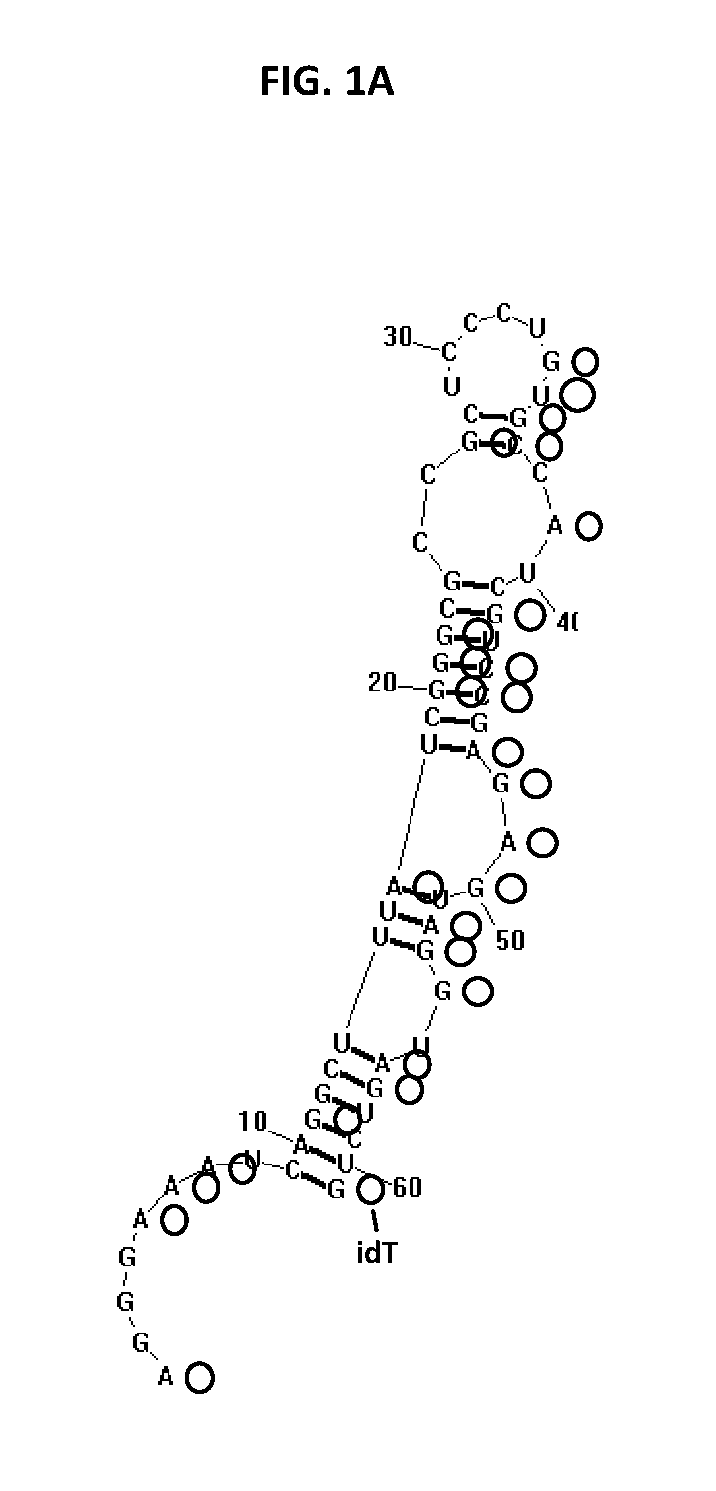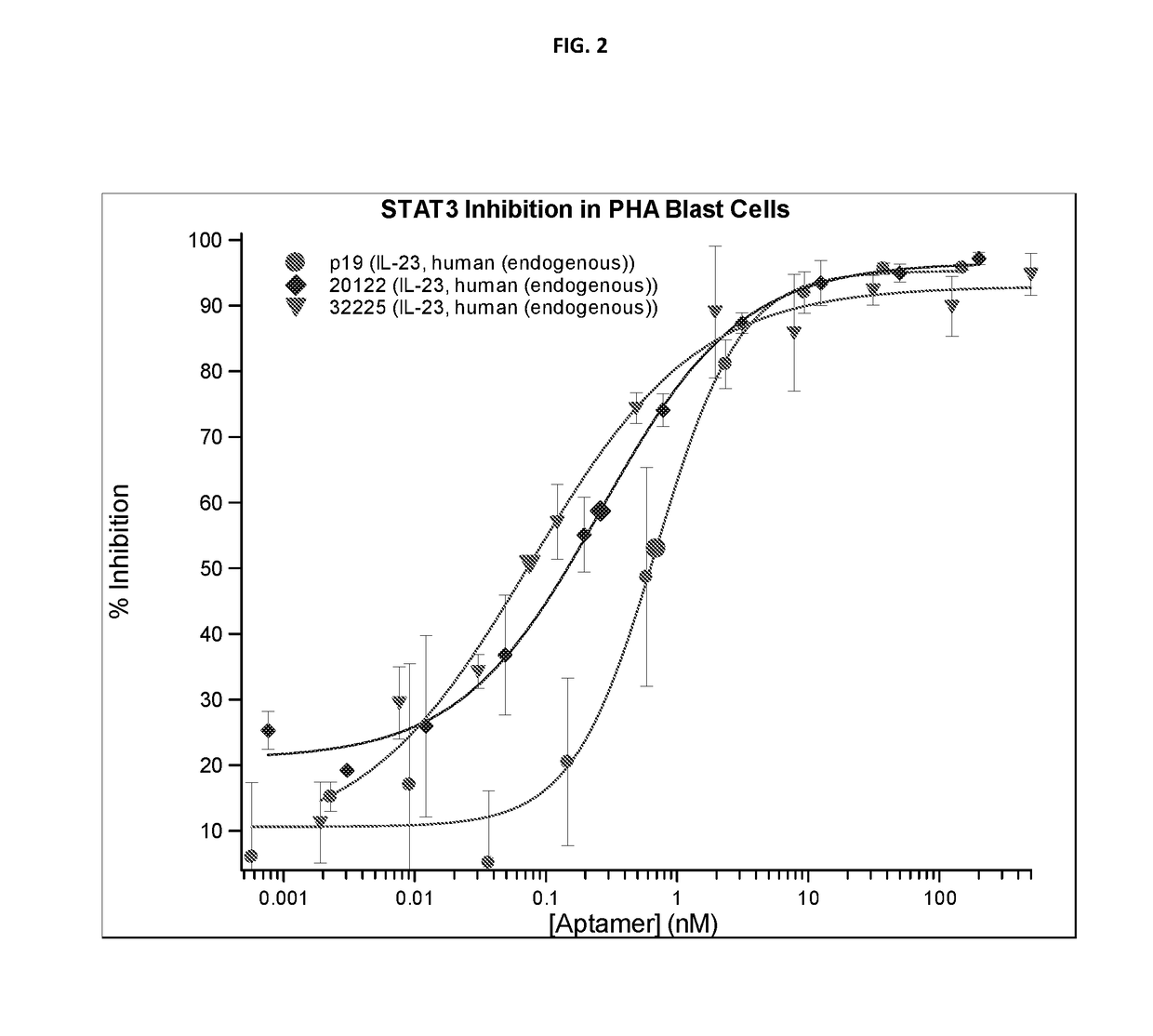Aptamers for topical delivery
a technology of aptamers and topical delivery, applied in the direction of osmotic delivery, drug composition, aerosol delivery, etc., can solve the problem of skin presenting a formidable barrier for topical delivery, and achieve the effect of facilitating visual assessment and facilitating termination of medications
- Summary
- Abstract
- Description
- Claims
- Application Information
AI Technical Summary
Benefits of technology
Problems solved by technology
Method used
Image
Examples
example 1
and Initial Characterization of ARC32225
[0827]ARC32225 is a 62-residue oligonucleotide (FIG. 1A). This oligonucleotide is composed of ten 2′-O-methyladenosines (mA), one 2′-fluoroadenosine (fA), fourteen 2′-O-methylguanosines (mG), six 2′-fluoroguanosines (fG), three 2′-O-methylcytosines (mC), thirteen 2′-fluorocytosines (fC), one 2′-O-methyluridine (mU), thirteen 2′-fluorouridines (fU) and the 3′-terminus is capped with a single inverted deoxythymidine residue (idT) to protect against nuclease degradation. In vitro selection experiments to generate ARC32225 were conducted using a pool of modified oligonucleotide molecules, each of which was generated with mA, mG, fC and fU residues. Recombinant Interleukin 23 (IL-23) used in the selection was obtained from R&D Systems (catalog #1290-IL-010 / CF).
[0828]Iterative rounds of selection for binding to IL-23 followed by amplification were conducted to generate ARC20122, an 84 nucleotide long precursor to ARC32225.
[0829]The sequence of ARC20...
example 2
f ARC32225 on Endogenous IL-23 Activity
[0837]There are significant structural differences between available recombinant IL-23 and endogenous IL-23. Endogenous IL-23 was prepared from the conditioned media of activated purified primary human monocytes by affinity purification. Peripheral Blood Mononuclear Cells (PBMC) were obtained from buffy coats prepared from fresh human blood. Monocytes were isolated by adherence to CD14 coated magnetic beads (Miltenyi, Cologne, Germany). To induce and enhance IL-23 expression, monocytes were treated with LPS and anti-IL-10 blocking antibodies. After 24 hours, conditioned media was collected and frozen. Sepharose NHS agarose beads (Sigma, St. Louis, Mich.) were coupled with non-neutralizing p19 receptor monoclonal antibodies (eBioscience, San Diego, Calif.) and incubated overnight with pooled conditioned media from multiple donors. Beads were washed and endogenous IL-23 was eluted with acid, and neutralized with a TRIS-base, BSA containing buffer...
example 3
LR 3, 7, 8, or 9 Activation by ARC32225 In Vitro
[0844]The ability of ARC32225 to stimulate Toll-Like Receptors (TLR) 3, 7, 8 or 9 in human PBMCs was tested. The innate immune system mounts a rapid defense against invading bacteria, RNA and DNA viruses, and other pathogens. Some oligonucleotides are recognized by the innate immune system as potential pathogens stimulating an inflammatory response. TLR3 recognizes double stranded RNA and induces IL-6 release in plasmacytoid dendritic cells. Activation of TLR7 / 8 and 9 is sequence-dependent. Guanosine / uridine-rich single stranded RNA activates TLR7 / 8, whereas DNA containing unmethylated cytosine / guanosine hexamer motifs (CpGs) activates TLR9. Moreover, different classes of synthetic CpGs induce varying effects in PBMCs: Class A CpGs induce interferon alpha and interferon gamma expression and do not cause B cell proliferation. Class B CpGs induce a strong interleukin-6 response and initiate a proliferative response in B cells. The presen...
PUM
| Property | Measurement | Unit |
|---|---|---|
| molecular weight | aaaaa | aaaaa |
| molecular weight | aaaaa | aaaaa |
| skin temperature | aaaaa | aaaaa |
Abstract
Description
Claims
Application Information
 Login to View More
Login to View More - R&D
- Intellectual Property
- Life Sciences
- Materials
- Tech Scout
- Unparalleled Data Quality
- Higher Quality Content
- 60% Fewer Hallucinations
Browse by: Latest US Patents, China's latest patents, Technical Efficacy Thesaurus, Application Domain, Technology Topic, Popular Technical Reports.
© 2025 PatSnap. All rights reserved.Legal|Privacy policy|Modern Slavery Act Transparency Statement|Sitemap|About US| Contact US: help@patsnap.com



